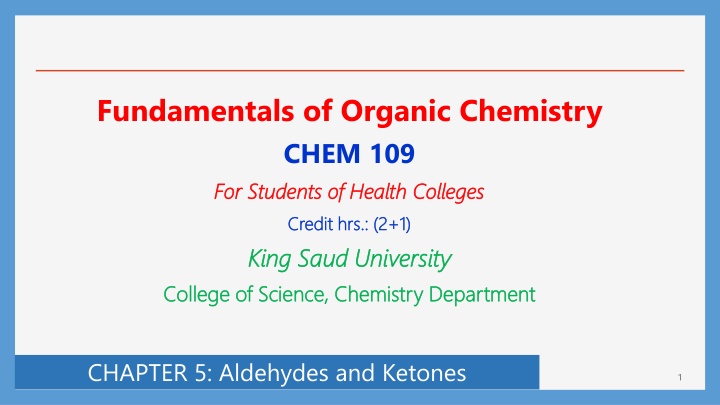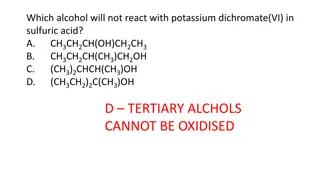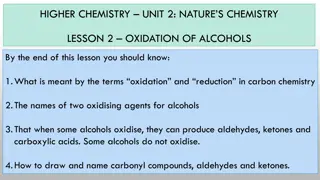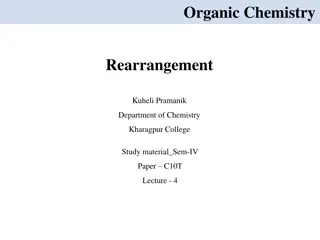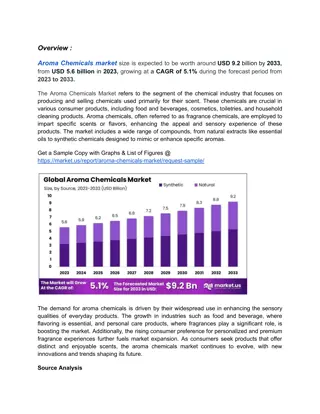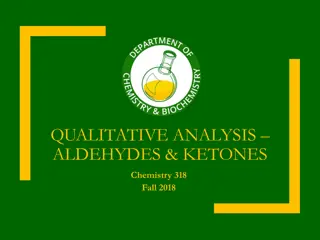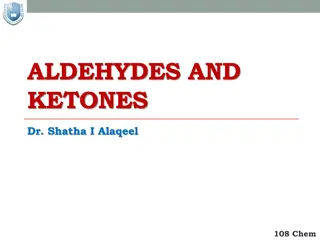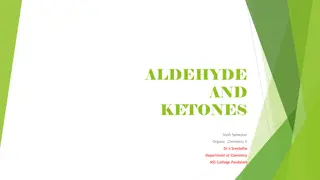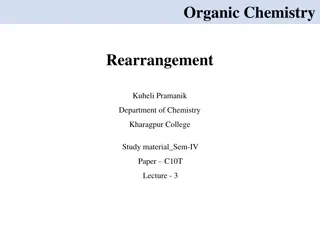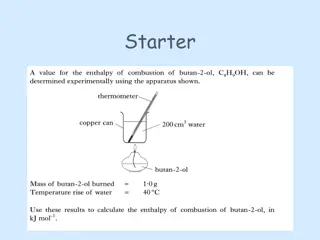Organic Chemistry Fundamentals: Aldehydes and Ketones
The chapter explores aldehydes and ketones, common classes of carbonyl compounds, the structure of the carbonyl group, and the nomenclature of aldehydes according to the IUPAC system. It discusses the characteristics, bonding, and nomenclature rules associated with these important functional groups in organic chemistry.
Download Presentation

Please find below an Image/Link to download the presentation.
The content on the website is provided AS IS for your information and personal use only. It may not be sold, licensed, or shared on other websites without obtaining consent from the author.If you encounter any issues during the download, it is possible that the publisher has removed the file from their server.
You are allowed to download the files provided on this website for personal or commercial use, subject to the condition that they are used lawfully. All files are the property of their respective owners.
The content on the website is provided AS IS for your information and personal use only. It may not be sold, licensed, or shared on other websites without obtaining consent from the author.
E N D
Presentation Transcript
Fundamentals of Organic Chemistry CHEM 109 For Students of Health Colleges For Students of Health Colleges Credit hrs.: (2+1) Credit hrs.: (2+1) King Saud University King Saud University College of Science, Chemistry Department College of Science, Chemistry Department CHAPTER 5: Aldehydes and Ketones 1
Common Classes of Carbonyl Compounds Class Class General Formula General Formula O Class Class General Formula General Formula O Ketones Aldehydes C R' R R H O O Carboxylic acids Acid Chlorides C R OH R Cl O O C C OR' Esters Amides R NH2 R 2
The Carbonyl Group The carbonyl group C O o The carbon oxygen double bond consists of a sigma bond and a pi bond. o The carbon atom is sp2-hybridized. o The three atoms attached to the carbonyl carbon lie in a plane with bond angles of 120 . o The pi bond is formed by overlap of a p orbital on carbon with an oxygen p orbital. o There are also two unshared electron pairs on the oxygen atom. o The C=O bond distance is 1.24A, shorter than the C-O distance in alcohols and ethers (1.43A). 3
The Carbonyl Group o Oxygen is much more electronegative than carbon. Therefore, the electrons in the C=O bond are attracted to the oxygen, producing a highly polarized bond. o As a consequence of this polarization, most carbonyl reactions involve nucleophilic attack at the carbonyl carbon, often accompanied by addition of a proton to the oxygen (electron rich). 4
Structure of Aldehydes and Ketones o Aldehydes Aldehydes and and ketones ketones are characterized by the presence of the carbonyl group. o Aldehydes Aldehydes have at least one hydrogen atom attached to the carbonyl carbon atom. The remaining group may be another hydrogen atom or any aliphatic or aromatic organic group. The -CH=O group characteristic of aldehydes is often called a formyl group. o In ketones, ketones, the carbonyl carbon atom is connected to two other carbon atoms. 5
Nomenclature of Aldehydes IUPAC System o Aliphatic Aliphatic aldehydes the same carbon skeleton as the aldehyde and replacing it with the suffix -al. Alkane Alkane - - e e+ + al al = = Alkanal aldehydes are named by dropping the suffix -e from the name of the hydrocarbon that has Alkanal o Substituted Substituted aldehydes, -CH=O group is assigned the number 1 position. Aldehyde group has priority over a double bond or hydroxyl group. aldehydes, we number the chain starting with the aldehyde carbon. 6
Nomenclature of Aldehydes IUPAC System o Cyclic Cyclic aldehydes, aldehydes, the suffix carbaldehyde is used. o Aromatic Aromatic aldehydes benzaldehyde. aldehydes are usually designated as derivatives of the simplest aromatic aldehyde, 7
Nomenclature of Ketones Common Names o Common names of ketones are formed by adding the word ketone to the names of the alkyl or aryl groups attached to the carbonyl carbon. Alkyl ketone. 8
Nomenclature of Ketones IUPAC System o In the IUPAC system, the ending for ketones is -one. o The chain is numbered so that the carbonyl carbon has the lowest possible number. o For cyclic ketones, numbering always starts from the C=O group. o The prefix "oxo" is used when the ketone is not the principal functional group. 9
Nomenclature of Aldehydes and Ketones NOTES o In In common common names o The atom adjacent to the function is alpha ( ), the next removed is beta ( )and so on. Since ketones have two sets of neighboring atoms, one set is labeled , etc., and the other ', ' etc. names carbon atoms near the carbonyl group are often designated by Greek letters. o The functional group priority order in nomenclature system The functional group priority order in nomenclature system is as following: Acid and derivatives >aldehyde> ketone> alcoho > amine > alkene > alkyne > ether 10
Physical Properties of Aldehydes and Ketones o Boiling Points Carbonyl compounds boil at higher temperatures than hydrocarbons, but at lower temperatures than alcohols of comparable molecular weight. This is due to the intermolecular forces of attraction, called dipole-dipole interactions, which is stronger than van der Waals attractions but not as strong as hydrogen bonds. 11
Physical Properties of Aldehydes and Ketones o Solubility Carbonyl compounds as aldehydes and ketones have a C=O bond, but no O-H bond, cannot form hydrogen bonds with themselves. The polarity of the carbonyl group also affects the solubility properties of aldehydes and ketones. Carbonyl compounds with low molecular weights are soluble in water as they can form hydrogen bonds with O-H or N-H compounds. 12
Preparation of Aldehydes and Ketones 1) Oxidation of Primary and Secondary Alcohols 2) Hydration of Alkynes Hydration of terminal alkynes EXCEPT acetylene yields ketones (catalyzed by acid and mercuric). 3) Ozonolysis of Alkenes 13
Preparation of Aldehydes and Ketones 4) Friedel-Crafts Acylation Preparing ketones that contain an aromatic ring. 14
Reactions of Aldehydes and Ketones A) Reduction of Carbonyl Compounds o Aldehydes and ketones are easily reduced to primary and secondary alcohols, respectively. o The most common metal hydrides used to reduce carbonyl compounds are lithium aluminum hydride (LiAlH4) and sodium borohydride (NaBH4). B) Oxidation of Carbonyl Compounds o Oxidation of aldehydes gives a carboxylic acid with the same number of carbon atoms. o Because the reaction occurs easily, many oxidizing agents, such as KMnO4, CrO3, Ag2O and peracids will work. 15
Reactions of Aldehydes and Ketones C) Nucleophilic Addition Reactions o Nucleophiles attack the carbon atom of a carbon-oxygen double bond because that carbon has a partial positive charge. o The overall reaction involves addition of a nucleophile and a proton across the pi bond of the carbonyl group (when carried out in alcohol or water). 16
Reactions of Aldehydes and Ketones C) Nucleophilic Addition Reactions 1) Addition of Grignard Reagents: Formation of Alcohols o Grignard reagents act as carbon nucleophiles toward carbonyl compounds. o The reaction of a Grignard reagent with a carbonyl compound provides a useful route to alcohols. o The type of carbonyl compound chosen determines the class of alcohol produced. 17
Reactions of Aldehydes and Ketones C) Nucleophilic Addition Reactions 1) Addition of Grignard Reagents: Formation of Alcohols o Formaldehyde gives primary alcohols. o Other aldehydes give secondary alcohols o Ketones give tertiary alcohols. 18
Reactions of Aldehydes and Ketones C) Nucleophilic Addition Reactions 2) Addition of Hydrogen Cyanide: Formation of Cyanohydrins o Hydrogen cyanide adds to the carbonyl group of aldehydes and ketones to form cyanohydrins, compounds with a hydroxyl and a cyano group attached to the same carbon. o Example 19
Reactions of Aldehydes and Ketones C) Nucleophilic Addition Reactions 3) Addition of Alcohols: Formation of Hemiacetals and Acetals o Alcohols add to the C=O bond, the OR group becoming attached to the carbon and the proton becoming attached to the oxygen. o Aldehydes and ketones react with alcohols to form, first, hemiacetals and then, if excess alcohol is present, acetals. o Hemiacetals; it contains both alcohol and ether functional groups on the same carbon atom. o Acetals have two ether functions at the same carbon atom. 20
Reactions of Aldehydes and Ketones C) Nucleophilic Addition Reactions 3) Addition of Alcohols: Formation of Hemiacetals and Acetals o The reverse of acetal formation, called acetal hydrolysis. o Acetal can be hydrolyzed to its aldehyde or ketone and alcohol components by treatment with excess water in the presence of an acid catalyst. 21
Reactions of Aldehydes and Ketones C) Nucleophilic Addition Reactions 4) Addition of Ammonia and Ammonia Derivatives The addition of nitrogen nucleophile, such as ammonia(NH3) and substituted ammonia (NH2-Y). 22
